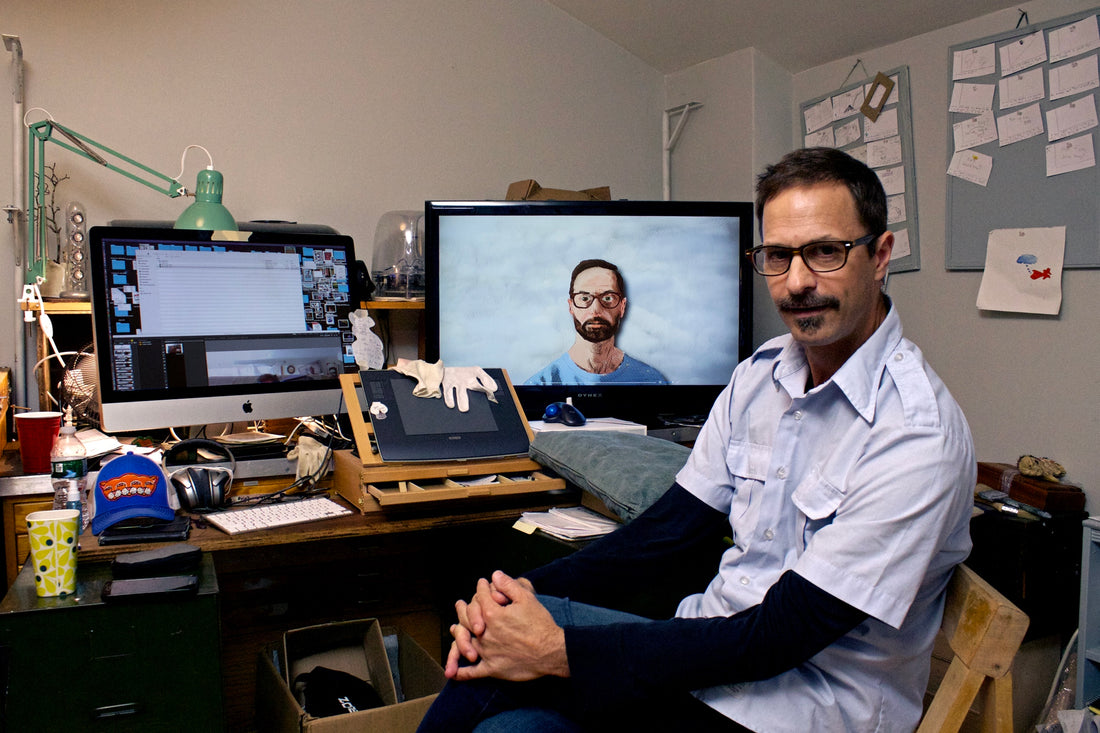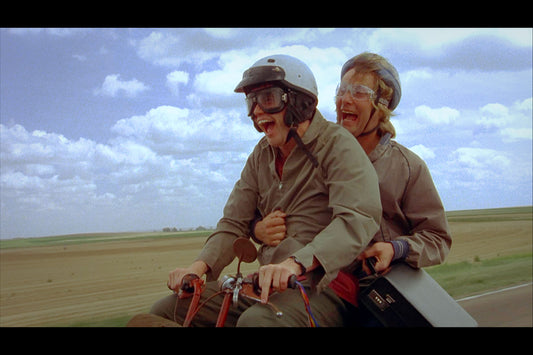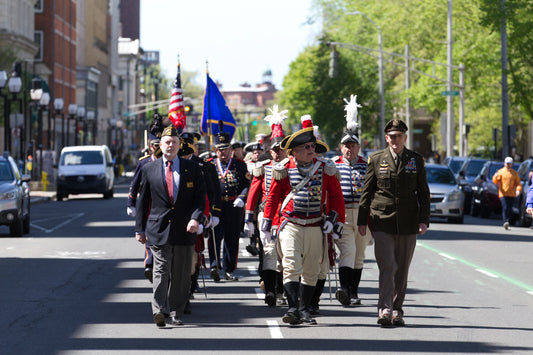In a corner room on the second floor of his house, Ed Gendron was getting ready for a busy November, his attention divided between current filmmaking projects and a finished one. Playing Soldier, his documentary about World War II reenactors, would soon be shown at the Yonkers Film Festival, its first public screening outside of New Haven. Meanwhile, prints from Reenactor Moment, the photo series that began his immersion in the world of battle reenactment, were about to be shown at Yale West Campus for City-Wide Open Studios Alternative Space Weekend.
“Right now I’m in the advertising stage of everything… Putting out things to get my art show seen. Putting out things to get butts in seats at the movie theater. I need to make a flyer, or I need to put out another Instagram post. Social media is its own juggling act,” Gendron says. He turns to open the Playing Soldier promo file folder on one monitor, demonstrating the minutiae of the promotional effort, cycling through variations of digital flyers that feature images from the project. Men and women in historically accurate Allied—and Axis—uniform provide an arresting visual, posed against a recognizably American backdrop. And in one of his composites, an arm sleeved in army green mock-flies a model World War II bomber—which perhaps even better captures the obsessive spirit of historical reenactment.
sponsored by
On the other monitor, a bird’s eye illustration of a golf cart sits on a field of red and, superimposed, a very rough head-and-shoulders close-up of a man holding what Gendron reveals to be a Solo cup. It’s a tantalizingly incomplete glimpse of a new project, and I happened to arrive on a day Gendron had set aside for new projects. “I try to compartmentalize as much as I can. I’ll put them in a pile and go, ‘Tuesday, that’s what I’m doing.’ Social media stuff. ‘And Wednesday I’m going to draw and try to get some of this done.’” He hits a key, and, in a few frames, the golf cart begins to traverse the field. It’s an animatic, a moving sketch of an animated sequence that will one day nest inside a live-action documentary about a musician he’s not yet at liberty to name. It was at NHDocs 2019—a.k.a. the 2019 New Haven Documentary Film Festival, where he had screened Playing Soldier with an animated preface—that Gendron was approached for this commission. Film festivals that make independent work visible also provide unexpected opportunities to keep working, which is why Gendron’s social media stuff gets a whole Tuesday. Gendron adds with a shrug, “It’s part of the process to actually put it out there and have somebody experience it.”
This is especially true of a creation process that lasts for years, as Playing Soldier did. In the span of a decade, Gendron drove up and down the East Coast to attend 20 or 30 reenactments, which typically happen annually and take up entire weekends. From there, characters emerged who warranted further exploration, including a family who would arrive in vintage clothes and yellow badges of the kind German Jews were compelled to wear in 1938. “This family would just show up,” Gendron says, “and just walking through was in itself… kind of poking the bear a little bit.” Gendron sporadically encountered Nazi sympathizers and Holocaust deniers at the events, but reactions to the family walk-throughs also varied among reenactors who were in it solely for the military hardware. “I was just standing there with my hands in my pockets,” Gendron recalls, “and I saw them walk by and it took me a minute to register, and I ran into the tent, got my camera in the dark, and off I go to chase them down.” The film also features a Jewish woman who attends reenactments as Nazi filmmaker Leni Riefenstahl. Gendron, sympathetic to my bemusement, says, “That was a big part of
Gendron’s process was also a matter of unusual professional immersion. The “reenactor moment” after which the photo collection is named is the “little piece in time, very short and fleeting,” when reenactors come to believe they are soldiers fighting in a European field and not mustering in a municipal park. “There’s always a lot of effort to suppress the present,” Gendron notes. “I’ve seen people go as far as to build elaborate shells that will go around a stop sign and make it look like a concrete sign from France in the 1940s.” Gendron adopted their methods to make himself a part of the environment. He built a replica of a newsreel camera and placed his contemporary camera inside it. He bought a vintage uniform on eBay. “I was a war photographer—proper insignia and all that good stuff. There was a time when I was outside in the cold and I was developing from negatives in freezing cold water. That was my little reenactor moment.”
Gendron reflects on all that time and effort with a certain equanimity. The filming, he says, is “the easy part because you’re just compelled to do it. This other stuff is harder, raising money and making these technical things that are necessary.” When he was finished editing the film, he launched a crowdfunding campaign to raise money for post-production—“color balance, sound balance, things that require experts with the correct tools.”
Commissioned work relieves a filmmaker of those concerns, ideally leaving enough creative leeway that the filmmaker still feels creatively engaged. The golf cart animatic on Gendron’s monitor is a particularly engaging creative effort, representing as it does the extracurricular activities of a reasonably famous alt rock musician. Gendron elaborates, “As the story goes,
The surreal visual vocabulary of both of these projects—unusual doings in public outdoor spaces—suits Gendron’s own taste for the surreal in film, which he discovered early as a student filmmaker at Radford University in Virginia. “I didn’t want to make the next Herbie Goes To Dallas.” The expressive possibilities of fact-based filmmaking occurred to him later, attending the Full Frame Documentary Film Festival in Durham, North Carolina, where his wife’s work as an academic art librarian had then taken them. (Heather Gendron is also an artist, with her own studio at the opposite corner of the house.) “It changed my ideas of what a
Gendron’s camera has lately been employed to produce a music video for local singer Thabisa, as well as a pitch for a high profile-sounding project he is also bound to say little more about. Both connections were made at NHDocs—the latter after the producers had seen one of his Playing Soldier posters on display there—and came at an ideal time, when Playing Soldier as a creative undertaking was already in the past. “I’d always likened the end of those long-term projects to a divorce. There’s nothing but this overwhelming quiet that’s difficult to listen to. And so I wanted something to just drown that out.” Gendron takes an appraising glance at a stack of small cardboard boxes, each representing and containing its own project. “And now that I’ve got this stuff, I’m starting to think again about making another film. I think I really, really did need this as a stepping stone.”
Ed Gendron
Website | Contact | Playing Soldier
Written and photographed by David Zukowski.








